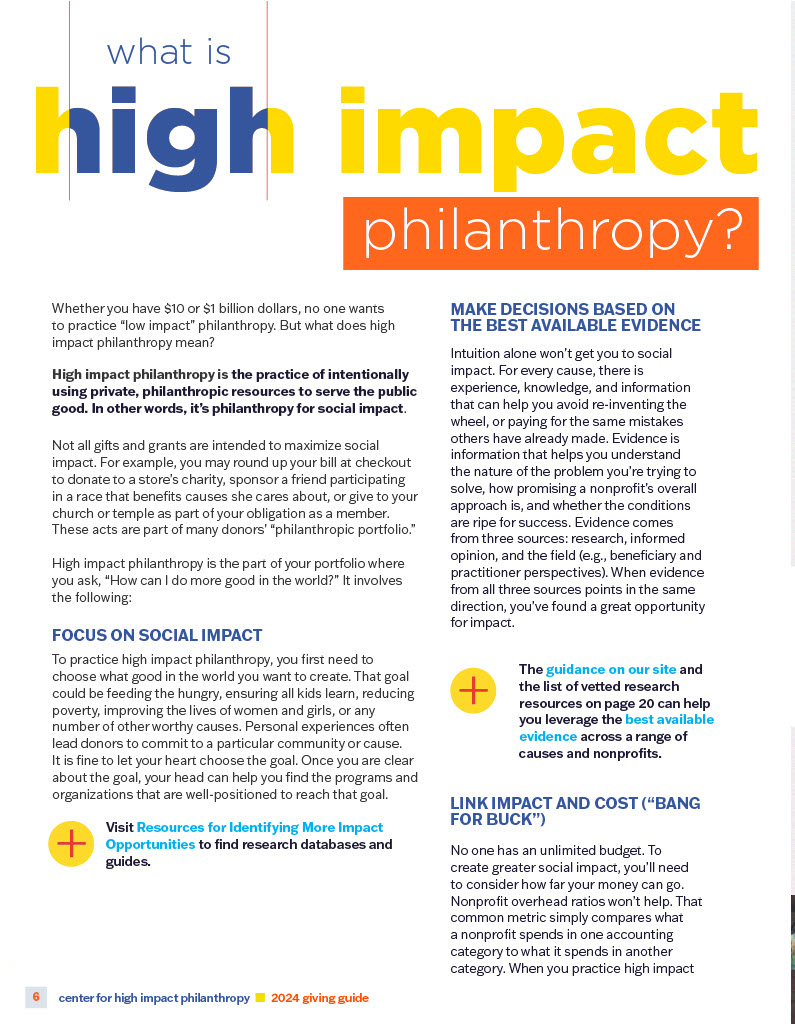Whether you have $5 or $5 billion, no one wants to practice “low impact” philanthropy. But what does high impact philanthropy mean?
High impact philanthropy is the practice of intentionally using private philanthropic resources to serve the public good. In other words, it’s philanthropy for social impact. Not all gifts and grants are intended to maximize social impact. For example, you may round up your bill at checkout to donate to a store’s charity, sponsor a friend participating in a race that benefits causes she cares about, or give to your church or temple as part of your obligation as a member. These acts are part of many donors’ “philanthropic portfolio.”
High impact philanthropy is the part of your portfolio where you ask, “How can I do more good in the world?” It involves the following:

Focus on social impact
To practice high impact philanthropy, you first need to choose what good in the world you want to create. That goal could be feeding the hungry, ensuring all kids learn, reducing poverty, improving the lives of women and girls, or any number of other worthy causes. Personal experiences often lead donors to commit to a particular community or cause. It is fine to let your heart choose the goal. Once you are clear about the goal, your head can help you find the programs and organizations that are well-positioned to reach that aim.

Make informed decisions
Intuition alone won’t get you to social impact. For every cause, there is experience, knowledge, and information that can help you avoid re-inventing the wheel, or paying for the same mistakes others have already made. Evidence is information that helps you understand the nature of the problem you’re trying to solve, how promising a nonprofit’s overall approach is, and whether the conditions are ripe for success. Evidence comes from three sources: research, informed opinion, and the field (e.g., beneficiary and practitioner perspectives). When evidence from all three sources points in the same direction, you’ve found a great opportunity for impact.

Think impact AND cost (“bang for buck”)
No one has an unlimited budget. To create greater social impact, you’ll need to consider how far your money can go. Nonprofit overhead ratios won’t help. That common metric simply compares what a nonprofit spends in one accounting category to what it spends in another category. When you practice high impact philanthropy, you want to understand what a nonprofit can achieve given everything it spends. That’s “bang for buck” thinking, where the “bang” is the social impact, and the “buck” is the money spent to achieve that impact.
There are many ways to link impact and cost. You could take results (e.g., number of participants earning a living wage, tons of CO2 emissions averted) and compare those results to the money required to achieve those results. You could also compare costs to societal benefits, like when $1 spent on a home visitation program yields $5 in societal benefits from lower social welfare costs and increased tax revenue because participating children are healthier and stay in school longer.
When you start thinking this way, you’ll gain a more realistic understanding of what it takes to create social impact, and you’ll recognize opportunities where your money might go even further.

Keep learning and adjusting
Philanthropy is not a perfect science. The issues that donors tackle are among the toughest society faces. You’ll make mistakes, and your donation may not achieve what you hoped. But the more you assess, learn, and apply what you learn, the more you’ll improve, and the more social impact you’ll achieve. Connecting with other funders can often accelerate learning; alumni of our High Impact Philanthropy Academy report that the network they gained has been one of the biggest benefits. Your local community foundation, giving circles, the due diligence of staffed foundations, funder membership groups, and public resources like those listed in our resources page can all be sources of people and information to learn from and with.
High impact philanthropy is not about how much you give, but how well you give. By focusing on social impact, using the best available evidence, thinking “bang for buck,” and learning as you give, your generosity and good intentions can result in social impact year-round and in the years to come.

